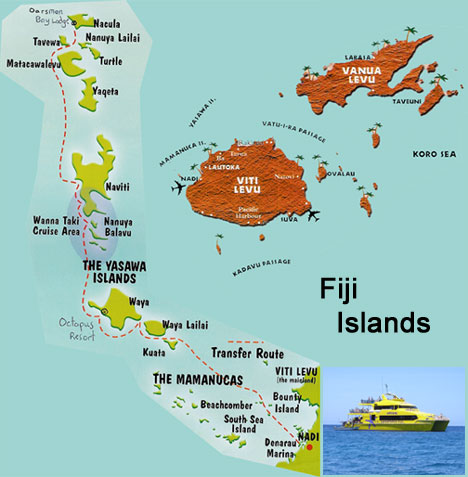 So, if you have been hearing about impending coups in Fiji (as we have), no worries. Past coups have been confined to Suva, the capital. The tourist areas just ignore them.
So, if you have been hearing about impending coups in Fiji (as we have), no worries. Past coups have been confined to Suva, the capital. The tourist areas just ignore them.
| Previous |
Next |
Bula (hello),
Here we are in Fiji, a country made up of 300 islands. In Fiji, the population is a combination of native Fijians and Indo-Fijians (descendants of indentured workers). The politicians representing these two groups are constantly in a power struggle, but common folk seem to get along just fine.
 So, if you have been hearing about impending coups in Fiji (as we have), no worries. Past coups have been confined to Suva, the capital. The tourist areas just ignore them.
So, if you have been hearing about impending coups in Fiji (as we have), no worries. Past coups have been confined to Suva, the capital. The tourist areas just ignore them.
We first visited Fiji seven years ago on our way to Australia, staying on the main island of Viti Levu. This time we made straight for the Yasawas, a 90-mile long chain of 20 islands in the northeast with no banks, no shops, no medical services, and a handful of villages. What is the attraction? Scattered throughout the islands are resorts set on sandy beaches and overlooking clear blue coral-studded lagoons.
Q: How do you get to the Yasawas?
A: After a nine-hour stay in the nearly empty Tongan airport, we flew in late to Nadi, Fiji and stayed at a nearby hotel. Early the next morning, we boarded the inter-island ferry, the Yasawa Flyer, for the islands. Also known as the yellow boat, this 25 meter long catamaran is the Fiji version of mass transit. Each morning the Flyer leaves the mainland carrying passengers and supplies for the islands. It makes frequent stops, but not at wharfs or docks. When nearing a resort island, the Flyer stops out in mid-water. Small motorboats filled with tourists and luggage from the nearby resorts come to meet it. Passengers and luggage are put onboard the Flyer and new ones take their places on the small motorboats, which then go back to their respective resorts. The Flyer staff has this down to a science. It is a little shaky stepping off/on the smaller boats but there are plenty of people to lend a hand.
The Flyer heads north about 60 miles, then circles south, stopping again at the same resort areas it did earlier in the day. If you are first arriving at the islands or heading further north to another resort, you catch the morning pass of the Flyer. If you are heading to southern resorts or going back to the mainland, you catch the afternoon Flyer visit.
This constant flow of people is based on the premise that most visitors will stay at more than one resort. Some stay a day or two at a place, then move on to whichever resort has an opening by making arrangements on the Flyer itself. This can be risky as the popular spots fill up early. One young man, while waiting for an opening, slept on the resort's trampoline for a night. Other tourists, like us, stay a little longer at places where we have made reservations months ago.
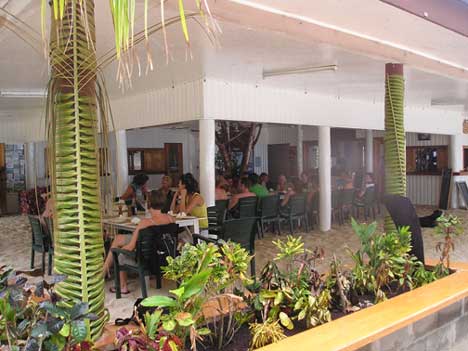
Q: What are the resorts like?
A: The variety of accommodations and prices are quite varied. If you are on a strict budget, you can stay in a dorm at a resort with limited running water and bring your own food. Most of the resorts have combinations of small private bungalows (called bures, pronounced burr-ay), some dorm rooms, and maybe space for a tent or two. Also, most resorts provide two or three meals a day. The high-end resorts have private airports, air-conditioned rooms, and fancy restaurants. But we only read about these, since at over $1,900 U.S. a night (plus 15.5% tax) it is far beyond our means and comfort level.
The differences in the resorts is based on how primitive the accommodations, the food, the quality of the beach, and what other amenities are available. These can include private bathrooms, dive shops, on-site kayaks and snorkeling, fresh water pools, massages, etc. Most resorts have a central building that contains the office, kitchen, a dining/activities area, and a bar. They are usually open air with sand as the floor. In fact, once you get on the Flyer, you never really need to wear shoes of any type on your whole vacation, unless you want to take a hike. The bures, tents and dorms surround the dining area. Also, the resorts set up daily trips to local villages, caves, snorkeling reefs, and other sites. So you can plan your days to be as busy as you wish.
Q: Where did you stay?
A: This was a difficult decision. We read the guidebooks and looked at the websites, but unless you talk to people who have been there, you never know what you will actually get. We were looking for a place that had a bure with a private bath, on a beach with good snorkeling, included three meals, had some interesting sites nearby, and was within our budget. We found two resorts that seem to fit the specs.
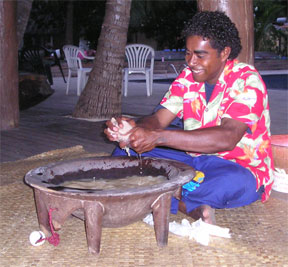
Octopus Resort on Waya Island (3 nights): About two and a half hours along the Flyer route, we were picked up by a small boat. As it approached the resort, we could see a long white beach and could hear (we would find out later) the traditional Fijian welcome song, sung by the resort staff and accompanied by guitar and ukulele. We hopped out of the boat into the water (the start of the barefoot vacation) and up the sands. We have lugged our 20+ kilogram packs (over 40 pounds) all over the South Pacific, so it was pure luxury to have someone else (the staff) transport them to our destination. We were greeted by another staff person passing out cold fruit juice to drink during our orientation meeting. We could get used to this treatment if we could afford it more often!
Our bure was a 15 foot by 15 foot thatched roofed hut made of local wood with modern screened windows and a ceiling fan. There was only a bedroom area and a bathroom. The shower had no ceiling but plenty of hot and cold water. The floors were tiled but, despite the footbath outside the door, we were always tracking in sand. A mosquito net surrounded the bed and a mosquito coil burned at night. Fortunately, due to the constant breeze, mosquitoes were not a problem.
The bure was just a short walk from everything. This resort had a deep freshwater pool that also served as a scuba training area. The pool area was the gathering place day and night with the poolside serving as stage for traditional dances and seating for the Sunday night movie.
Meals for the 60+ guests were served in a large roofed building open to a huge deck. Breakfast was fruit, cereal, and toast. Of course, there were bananas, pineapple, and papaya. Lunch was a choice of 12 entrees ranging from local fish burgers to curry to pumpkin/green bean salad. We lucked out on dinner. One night was a Fijian buffet with lots of local delights including three kinds of fish. The second night was a barbeque of steak, chicken, lamb, fish and/or veggies with lots of different salads. The third night was a fish pie (fish with a mashed potato crust). You might see a pattern here (fish). The resort used locally raised and caught food whenever possible. We love fish and have grown to appreciate how many different ways pumpkin can be cooked (custard, stir-fry, soup, salad), all delicious.
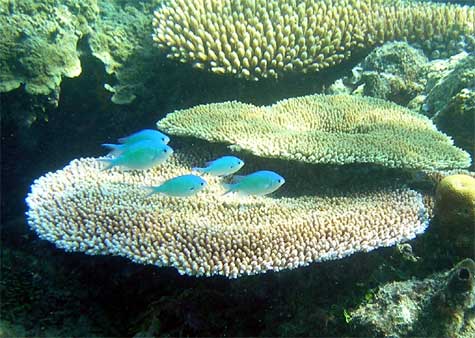
During the day, we snorkeled right off shore on a coral reserve being maintained by the resort. There were not a lot of new fish but the coral colors were outstanding. One evening we did a night snorkel (our first), using underwater flashlights to spot two types of lobsters, a couple of crabs, and a few fish. The night snorkel was a little scary at first, but since we had covered this area during daylight and could locate our fellow snorkelers and guide easily by their lights, we soon became quite comfortable. Besides, sharks and other potential dangerous animals are extremely rare in the area. Although we are not ones for tanning on the beach, it was easy to read or doze off in the lounge chairs in the shade. And this is after sleeping 10 hours! I know I will think of this time fondly as I wake up in February for my 7:30 a.m. office hour.
On Sunday morning, a group of us hiked over the island ridge to the village to attend church. The village was very small (about 200 people) with simple homes. Most of the children go off to a boarding school in another village for the weekdays, but Sunday is family day in the village. The church (Methodist) was plainly adorned and was obviously the center of the village life. Except for the Bible reading, the service was in Fijian. It was very hot with little air circulation. But the minister gave a rousing sermon in what Tim called a "preachy voice", shouting loudly and waving his hands around, keeping us awake. Di was worried he would knock the nearby vase off the lectern, so she was on the edge of her seat. We do not know what he said, but we are sure the fear of God was in there somewhere. Occasionally you would hear a squeaky high voice sing a few notes and the choir would break into four-part harmony without instrument backup. The voices were powerful and filled the church.
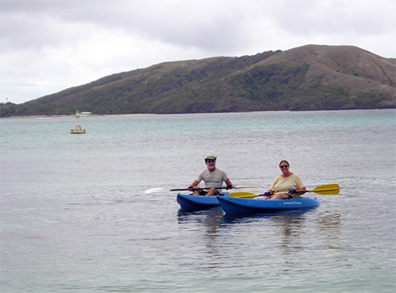
Oarsman Bay Lodge on Nacula Island (4 nights): Accompanied by the Octopus staff singing the Fijian farewell song, we boarded the small boat for the Flyer. A couple of hours later we disembarked onto Joe's Water Taxi, one of the Oarsman Bay Lodge's transports. Again, the barefoot entry, the welcoming song, welcoming glass of juice, orientation meeting, and someone else carrying our luggage to the bure. Oarsman Bay is a smaller resort (about 35 guests). There was no pool (alas), but more opportunities to take excursions off the resort.
The island, Nacula, had been suffering from drought for several months, so water rationing was in effect. We were limited to water (showers, toilet) from 8 to 10 a.m. and 6 to 8 p.m. with a large bucket of fresh water to last us for the times in between. Also, when running, the water supply was not drinkable so you depended on purchased bottled water. Although this was not a great hardship, coming out the salt water left us feeling sticky (and probably stinky) all day. It did get worse. Due to the low water level in the well, the resort water pump burned out and left us with no running water for 36 hours. We did learn to make judicious use of the bucket, though. When a downpour started on that afternoon (the first in months, they said), people were yelling for joy and dancing in the rain. Another situation where we realized the things we take for granted like washing machines and hot showers. The new pump was brought in by seaplane and the plumber by boat, so we did get back to our rationing schedule. Even that seemed just fine after the bucket days.
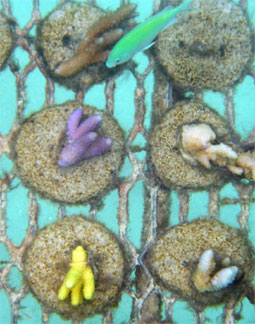
At Oarsman, we spent a lot of time snorkeling in front of the resort and did a bit of kayaking one morning at high tide (see attached). There were some outstanding corals and some easily seen clownfish, but there were still large areas of dead and dying coral. All throughout the South Pacific, we have seen many places where the coral was dead due to both natural causes (like storms and water temperature changes) and human causes (like harvesting and dynamite fishing). Oarsman Bay is the site of an experiment to restore the area's coral. An American man had come in and taught a couple of the villagers how to create a coral nursery. Just a few feet under the water, they constructed metal tables with a lattice top (easy to see while snorkeling). On the tables were a series of small cement "cookies", each with a bit of coral tied to it. These coral fingers were starting to grow and would eventually be transplanted to the reef. The size of the cookie determined the size of the coral before transplanting. We met a videographer who was creating a film for Fijian villagers on the project, in hopes of spreading the project throughout the country. As there is an international coral market, this project may not only help restore the reefs but provide villagers with an income. A couple of snorkeling excursions to other reefs nearby made us realize how important such projects are to the health of tropical waters all over the world.
At present, we are on our four-hour return via Yasawa Flyer to Nadi, then on to Hawaii. So it is back to the land of the dollar bill, Taco Bell, and drinkable water (we hope). Vinaka (thanks) and moce (goodbye).
Di & Tim
| Page Top |
Map |
Itinerary |
Previous |
Next |
| Tim and Diane's email address is ttdk@comcast.net | ||||